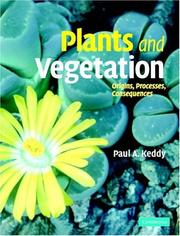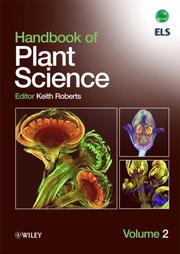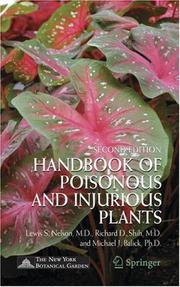| Listing 1 - 5 of 5 |
Sort by
|
Book
ISBN: 9782804150204 2804150208 Year: 2007 Publisher: Bruxelles: De Boeck,
Abstract | Keywords | Export | Availability | Bookmark
 Loading...
Loading...Choose an application
- Reference Manager
- EndNote
- RefWorks (Direct export to RefWorks)
La biologie végétale en pleine évolution ! La biologie des plantes est un domaine d'études, de recherches et d'applications pratiques fascinant. Des progrès importants ont été réalisés dans la plupart des disciplines des sciences végétales. Depuis l'étude de relations évolutives jusqu'aux recherches sur la génomique et sur le fonctionnement des plantes, ces progrès améliorent notre connaissance des végétaux et ils ont des implications durables dans notre vie. Superbement illustré, cet ouvrage a pour but de donne une vue d'ensemble de la biologie des plantes et des organismes photosynthétiques (algues, champignons bactéries...). Cette nouvelle édition, mise à jour, intègre les progrès de la recherche, les explique, les illustre. Les auteurs ont cherché à rendre le texte plus accessible aux étudiants en simplifiant la rédaction et en réorganisant le texte pour plus de clarté. Les illustrations sont plus nombreuses, plus complètes avec des légendes plus importantes. Une approche centrée sur l'évolution et sur la biodiversité. La structure et le fonctionnement des organismes végétaux sont décrits ainsi que leur origine évolutive, leurs relations mutuelles et leur classification, leur répartition dans les différents milieux, leurs interactions avec les autres plantes ainsi qu'avec le monde animal, leur rôle dans les équilibres biologiques, dans l'écologie globale et dans la biodiversité. L'ouvrage insiste sur la nécessité de connaître les plantes afin de permettre la recherche de solutions aux problèmes liés aux activités humaines et à la surpopulation. Les 32 chapitres sont structurés en 7 parties : Biologie de la cellule végétale, Energétique, Génétique et évolution, Diversité, Angiospermes : structure et développement de la plante, Physiologie des spermatophytes, Ecologie. Traduction de la 7e édition américaine.
Plant Physiological Phenomena --- Biology --- Plants --- BOT General Botany --- general botany --- handbooks --- Botany --- Botanique --- Handbooks, manuals, etc. --- Plant biology --- Textbooks

ISBN: 9780521864800 0521864801 9780511812989 0511289081 9780511289088 9780511649165 0511649169 9780511287084 0511287089 9780511291197 0511291191 0511812981 0511573278 9780511573279 1107178525 1282466887 9786612466885 0511645074 0511288409 Year: 2007 Publisher: Cambridge New York Cambridge University Press
Abstract | Keywords | Export | Availability | Bookmark
 Loading...
Loading...Choose an application
- Reference Manager
- EndNote
- RefWorks (Direct export to RefWorks)
Plants make up 99.9 percent of the world's living matter, provide food and shelter, and control the Earth's climate. The study of plant ecology is therefore essential to understanding the biological functions and processes of the biosphere. This vibrant introductory textbook integrates important classical themes with recent ideas, models and data. The book begins with the origin of plants and their role in creating the biosphere as the context for discussing plant functional types and evolutionary patterns. The coverage continues logically through the exploration of causation with chapters, amongst others, on resources, stress, competition, predation, and mutualism. The book concludes with a chapter on conservation, addressing the concern that as many as one-third of all plant species are at risk of extinction. Each chapter is enriched with striking and unusual examples of plants (e.g., stone plants, carnivorous plants) and plant habitats (e.g., isolated tropical tepui, arctic cliffs). Paul Keddy writes in a lively and thought-provoking style which will appeal to students at all levels.
Plant ecology --- BOT General Botany --- vegetation --- ecology --- biodiversity --- conservation --- Plant ecology. --- Botany. --- Botanical science --- Floristic botany --- Phytobiology --- Phytography --- Phytology --- Plant biology --- Plant science --- Biology --- Natural history --- Plants --- Botany --- Phytoecology --- Vegetation ecology --- Ecology --- Floristic ecology

ISBN: 9780470057230 0470057238 Year: 2007 Publisher: Chichester : Wiley,
Abstract | Keywords | Export | Availability | Bookmark
 Loading...
Loading...Choose an application
- Reference Manager
- EndNote
- RefWorks (Direct export to RefWorks)
Botany --- Botanique --- Plante --- plants --- Tissu végétal --- Plant tissues --- Anatomie végétale --- plant anatomy --- Biotechnologie végétale --- Plant biotechnology --- Population végétale --- plant population --- Sciences végétales --- plant sciences --- BOT General Botany --- handbooks --- Botany. --- 58 <03> --- Botanical science --- Phytobiology --- Phytography --- Phytology --- Plant biology --- Plant science --- Biology --- Natural history --- Plants --- Botany--Naslagwerken. Referentiewerken --- 58 <03> Botany--Naslagwerken. Referentiewerken --- Floristic botany

ISBN: 0387312684 9780387312682 9786611140892 1281140899 0387338179 Year: 2007 Publisher: New York, NY : Springer US : Imprint: Springer,
Abstract | Keywords | Export | Availability | Bookmark
 Loading...
Loading...Choose an application
- Reference Manager
- EndNote
- RefWorks (Direct export to RefWorks)
In the 20 years that have passed since the publication of the first edition, both Poison Control Centers and Emergency Departments have witnessed an expansion in the number and variety of poisonings caused by toxic plants. At the same time, there is a proliferation in the diversity of plants in our gardens and homes, continually expanding the range of possible consequences from exposure to toxic plants. This second edition of the Handbook of Poisonous and Injurious Plants is created to assist the clinician in the initial response to the needs of a child or adult exposed to a poisonous or injurious plant. It lists common plants that might lead to the development of the symptom complex and describes the mechanisms of action of the implicated toxin, additional clinical manifestations, and specific therapeutics for each presentation. It has methodically enhanced the previous edition’s botanical rigor with insights from both pharmacognosy and clinical medicine to make it a truly comprehensive source. With its thorough references and full-color photos of hundreds of potentially toxic and injurious plants inside and outside the home, anyone who has an interest in plants will find this book useful outside in the garden or out in the wild. This book will fascinate botanists, horticulturists, and naturalists as well as hikers, gardeners, and all those who simply enjoy the wonders of nature and the great outdoors! With Foreword by Lewis R. Goldfrank, MD and Introduction by Andrew Weil, MD Advance reviews: "The Handbook of Poisonous and Injurious Plants, rich in visual images, emergency medical information, botanical descriptions, and scientific references, is the easiest to use and most comprehensive handbook of its kind available today. It will be of great value to physicians, naturalists, horticulturists, parents of small children, pet owners, and all those who interact with plants and the landscapes -- both indoors and outdoors -- in temperate, desert, tropical, and subtropical habitats throughout the year. This book is designed to become a well-thumbed addition to libraries, classrooms, and personal bookshelves. The authors are to be congratulated for producing such a useful, portable, and elegant guidebook to the plant toxins that are all around us." - Peter H. Raven, President, Missouri Botanical Garden, St. Louis, MO, USA "The Handbook of Poisonous and Injurious Plants by Nelson, Shih, and Balick is a thoroughly revised and updated. The new Handbook authors include a botanist and two physicians in the active practice of medical toxicology and emergency medicine. The resulting collaboration has resulted in a remarkable reference work – a slim, but lavishly illustrated handbook of only 300-plus pages that provides a detailed, medically oriented approach to plant poisonings and their management. The Handbook of Poisonous and Injurious Plants is an indispensable resource for every poison center and emergency department book shelf. Many pediatricians and emergency physicians will find it an invaluable addition to their personal libraries as well. " - Fred M. Henretig, MD, Director, The Children's Hospital of Philadelphia' s Poison Control Center, Philadelphia, PA, USA "This second edition of the Handbook of Poisonous and Injurious Plants is a remarkable improvement to a great book. It is much more logical and clinically relevant use of botany and medicine. Its new graphics and formal structure increases its value for the lay person and clinician." - Lewis R. Goldfrank, Chairman, Department of Emergency Medicine, New York University School of Medicine, Bellevue Hospital Center, New York, NY, USA.
Botan. systematics, taxonomy, nomencl. --- Toxicology --- Poisonous plants --- Plantes --- Plantes vénéneuses --- Handbooks, manuals, etc. --- Identification --- Pictorial works --- Toxicologie --- Guides, manuels, etc. --- Ouvrages illustrés --- Plant Poisoning --- Plants, Toxic --- Poisonous plants. --- Plants --- Poisoning --- Substance-Related Disorders --- Eukaryota --- Organisms --- Diseases --- Botany --- Public Health --- Earth & Environmental Sciences --- Health & Biological Sciences --- Botany - General --- Toxicology & Public Health --- ETH Ethnobotany & Economic botany --- poisonous plants --- handbooks --- Plantes vénéneuses --- Ouvrages illustrés --- EPUB-LIV-FT LIVBIOLO SPRINGER-B --- Plants, Poisonous --- Toxic plants --- Life sciences. --- Pharmacology. --- Emergency medicine. --- Plant science. --- Botany. --- Life Sciences. --- Plant Sciences. --- Life Sciences, general. --- Pharmacology/Toxicology. --- Emergency Medicine. --- Dangerous plants --- Plant defenses --- Toxicology. --- Medicine, Emergency --- Medicine --- Critical care medicine --- Disaster medicine --- Medical emergencies --- Chemicals --- Pharmacology --- Poisons --- Biosciences --- Sciences, Life --- Science --- Botanical science --- Phytobiology --- Phytography --- Phytology --- Plant biology --- Plant science --- Biology --- Natural history --- Drug effects --- Medical pharmacology --- Medical sciences --- Chemotherapy --- Drugs --- Pharmacy --- Physiological effect --- Floristic botany --- Poisonous plants - Toxicology - Handbooks, manuals, etc --- Poisonous plants - Identification --- Poisonous plants - Pictorial works --- PLANTS, TOXIC --- PLANT POISONING --- THERAPY --- DIAGNOSIS
Book
ISBN: 9789077503751 9077503757 Year: 2007 Publisher: Nijmegen Vantilt
Abstract | Keywords | Export | Availability | Bookmark
 Loading...
Loading...Choose an application
- Reference Manager
- EndNote
- RefWorks (Direct export to RefWorks)
De evolutieleer geldt vaak als een welomlijnde doctrine uit één boek: Charles Darwins The Origin of Species (1859). Maar al vóór verschijning circuleerden er uiteenlopende evolutionaire opvattingen en ook na de publicatie van Darwins meesterwerk bleef eensgezindheid uit. De evolutieleer bleek een kluwen van concurrerende theorieën met elk hun eigen logica en verborgen agenda’s. Heftig discussieerden Darwins intellectuele nazaten over de erfenis van hun grootvader. Raf de Bont bestudeert die debatten met het oog op de Belgische geschiedenis van de late negentiende en vroege twintigste eeuw. Hoe gaven wetenschappers en intellectuelen de evolutieleer voortdurend opnieuw vorm? Wat waren hun specifieke disciplines en lokale onderzoekstradities, hun ideologische overtuigingen en persoonlijke achtergronden?Darwins kleinkinderen is het verhaal van socialistische biologen enlaissez faire-kapitalisten, van wetenschappelijk geïnteresseerde romanciers en godvrezende geologen, van utopistische pedagogen en twistzieke museumconservators, van dwepende paladijnen en dwarse recensenten. De Bont schreef de biografie van een roerige familie, waarvan elk lid vocht om te overleven.
575.8 "18/19" --- 57 <09> --- Evolution. Origin of species. Phylogeny--19e en 20e eeuw. Periode 1800-1999 --- Biologische wetenschappen in het algemeen. Biologie--Geschiedenis van ... --- 19th century. --- 20th century. --- Academic collection --- 378.4 <493 KUL> --- BPB0806 --- 378.4 <493 KUL> Universiteiten: Katholieke Universiteit Leuven--KUL --- Universiteiten: Katholieke Universiteit Leuven--KUL --- Philosophical anthropology --- Evolution. Phylogeny --- Darwin, Charles --- anno 1800-1999 --- Belgium --- History of medicine --- Belgium. --- Evolution (Biology) --- Science --- Sciences --- History --- Histoire --- Belgique --- Intellectual life --- Vie intellectuelle --- Philosophy --- Darwin, Charles Robert --- History. --- Biologische wetenschappen in het algemeen. Biologie--Geschiedenis van .. --- Biologische wetenschappen in het algemeen. Biologie--Geschiedenis van . --- Biologische wetenschappen in het algemeen. Biologie--Geschiedenis van --- Evolutionnisme --- Darwinisme --- 19e siècle --- 20e siècle
| Listing 1 - 5 of 5 |
Sort by
|

 Search
Search Feedback
Feedback About
About Help
Help News
News